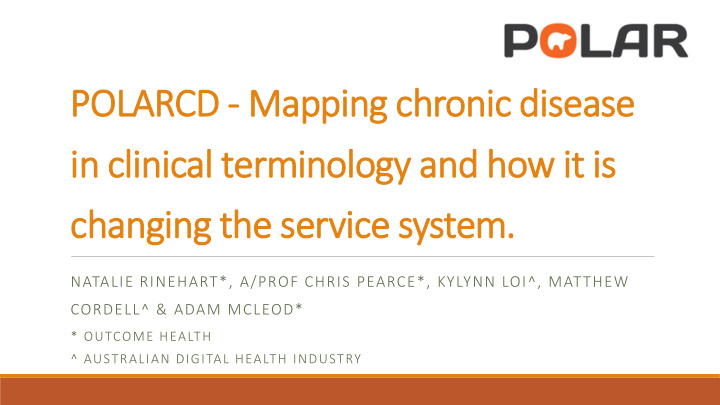



POLARCD - Mapping chronic disease in clinical terminology and how it is changing the service system. NATALIE RINEHART*, A/PROF CHRIS PEARCE*, KYLYNN LOI^, MATTHEW CORDELL^ & ADAM MCLEOD* * OUTCOME HEALTH ^ AUSTRALIAN DIGITAL HEALTH INDUSTRY
Chronic Disease According to the AIHW- Eight chronic disease groups are responsible for: • 39% of potentially preventable hospitalisations • 30% of problems managed by general practice • 73% of deaths Arthritis, asthma, back pain, cancer, cardiovascular disease, chronic obstructive pulmonary disease, diabetes and mental health conditions. This is just touching the surface of Chronic Disease in Australia AIHW (2016). Australia's’ Health 2016
Chronic Disease “Ineffective management of heart disease, asthma, diabetes and other chronic diseases costs the Australian health system more than $320 million each year in avoidable hospital admissions” “Primary Health Networks should be given more responsibility for coordinating local primary care services, and in regional areas, clear targets and well-designed incentives for disease prevention are vital .” Duckett, S. (2016). Chronic failure in primary care. Grattan Institute
Chronic Disease and Primary Care So how do PHNs and General Practice target the right patients to do this work? Patient groups need to be identified quickly and automatically for General Practice to intervene in a timely manner.
Outcome Health & POLAR • In 2011, Outcome Health (formerly Melbourne East GP Network) created a data warehouse with a vision that anyone could easily search for GP and population health data in a range of useful, easy to find, meaningful ways. • Since that time, the warehouse has continued to grow in scope and size and is now known as POLAR (POpulation Level Analysis & Reporting). Extraction • POLAR provides General Practices with auditing tools based on their patient data on Qliksense analysis dashboards to determine which patients need particular types of care. • POLAR provides PHNs with auditing tools based on the de-identified patient data of their practices for population health planning and primary care system reform.
GP Data mapping on POLAR POLAR has mapped a range of GP data types including: • GP coded and free-text diagnoses to SNOMED-CT-AU • Medications to World Health Organisation’s Anatomical Therapeutic Chemical (ATC) classification system. • GP relevant pathology groups mapped to LOINC codes. • Immunisation Groups • Radiology to SNOMED CT-AU
Why do we map? GP Data can be a mess- • Not all Mapped GPs enter to data the same way • Not all software collects data the same way
POLARCD: Mapping Chronic Disease POLAR took its SNOMED CT- AU diagnoses mapping and approached terminology specialists at Australian Digital Health Agency with an idea: An Australian SNOMED CT- AU mapping of Chronic Disease. It needed to speak to Australian concepts of Chronic Disease at an AIHW level and for the National Health Priorities. It needed to utilise SNOMED in a ‘proper’ but ‘practical’ form. POLARCD was born….
POLAR CD- Stage 1: ADHA As SNOMED CT-AU does not consistently model the course length of a disease, nor is the word “chronic” in the name of all chronic diseases (e.g Asthma, COPD), queries needed to be developed to be able to group the data based on their disease type.
POLAR CD- Stage 1: ADHA Nodes in the hierarchies identified for inclusion and exclusion Excluded: Included: Included:
POLAR CD- Stage 1: ADHA SQL queries were then created for each of the chronic disease groups and run against the GP data to give rough groupings. These were then passed back to POLAR for review.
POLARCD: Stage 2 POLAR reviewed the Stage 1 mapping and found it covered ‘disorders’ very well. But we needed it to cover more elements of SNOMED such as body structure and other clinical findings
POLARCD: Stage 2 We reviewed all our SNOMEDS for key search terms that were relevant to the chronic disease groups to build the queries. Clinical oversight about which SNOMEDs could be chronic was sought through our advising clinical staff.
POLARCD: Stage 2 Some codes that could be ‘precursors’ to a chronic disease were also removed.
POLARCD: In Use • POLARCD is now being used in the GP tools and the PHN aggregated tool (OUR GP’s). • Practices can now identify patients that may need higher practice support to manage their conditions. • PHNs can review patients that have an ‘active’ diagnoses for over 6 months. • PHNs can track geographically where patients are and which practices they want to partner with on interventions.
POLARCD: In Use • PHNs can review what proportion of their chronic patients have care plans or a shared health summary.
POLARCD: Conclusion • POLARCD constitutes one of the first operationalised SNOMED CT mapping of chronic diseases as understood within the Australian context. • PHNs can easily identify patients with chronic conditions to manage, track occurrences, trends and comorbidities across regional catchments. • GPs can quickly identify patient cohorts to manage through primary care interventions to reduce the likelihood of avoidable hospitalisations. These could include: • GPMP, TCA, GPMHP, Cycles of Care (Diabetes & Asthma) • Appropriate use of pathology to track patient outcomes • Uploading shared health summaries • Regular medication reviews and immunisations • Referrals to allied health, specialists and support services
Recommend
More recommend